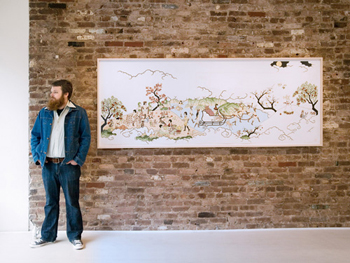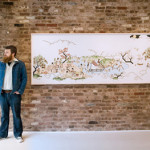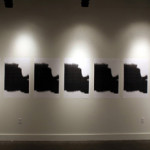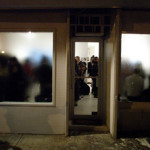By MICAH J. MALONE
Sean Horton has always had a knack for initiating projects. At one time or another, Sean has been integral to the founding of a record label, a gallery, an online arts journal and a graphic design business. What all of these projects share is a passion for finding new talent, keeping an independent and creative spirit in business and above all, I suspect, is the classic desire to own one's own labor. Originally hailing from the great state of Texas, Sean Horton made his way to Boston for the grad program at the Museum School. After graduating in 2004, Mr. Horton was immediately in the spotlight, at one point finding himself on the cover of The Boston Globe for both his work as an artist and independent curator. Sean left for Vermont shortly after graduation to curate exhibitions at the Firehouse Gallery in Burlington only to leave for a lucrative position at a new startup gallery by Nick Lawrence in New York City 6 months later. After a year as Director of Freight and Volume Sean thought it time to open his own space. In September of last year, SUNDAY was inaugurated in New York's Lower East Side to critical acclaim and speculative eyes. I caught up with Sean over the last few weeks to ask about his new space, the art market, his own projects and all the other great stuff you can read below. Enjoy.
MICAH MALONE: There are several artists that you have shown at your gallery SUNDAY that have a keen interest in biblical thematics, or at least an oblique spirituality (Ed Blackburn, Hilary Baldwin, Alexia Stamatiou, even Asuka Ohsawa). Are you naturally drawn to these artists for their religious / spiritual dimension and was it a conscious choice for you to have this dialogue in your gallery?
SEAN HORTON: Well, as you know, I was raised in tent revivals and mega-churches back in Texas. My mother’s husband was a failed minister and alcoholic who spent hours perfecting ink diagrams of the various eschatological dispensations in the back of his bible. The hours and hours of fire and brimstone sermons, speaking in tongues, and deliverance services eventually led me to a nearby bible college where I studied theology before stumbling upon art in an elective painting course. Those experiences aren’t quick to leave, nor would I want them to be. While I understand my experience more in terms of Texas vernacular now, it’s also been filtered through six years of art school – I do my best to retain the valuable aspects of it all and allow them to come to the surface naturally at SUNDAY.
Oddly enough, I don’t find the experience of a split-off independent church in an abandoned strip mall in Arlington, Texas to be that different from a barely-renovated storefront gallery in the Lower East Side. There’s a certain economy or attitude – like a pride in being on the periphery. I can just as easily say, “I don’t need your fucking pristine walls and high-dollar real estate. I can paint this place white and show art that rivals anything else in the city” as I could say “I don’t need your fucking pews and organized songs. I can get these folding chairs and play the guitar with my friends and call it church.”
I’m interested in as many different things in an artist as I am in the world. Religious culture is certainly an entry point into the work of several of the artists who have exhibited at SUNDAY – but it’s also a very diverse group. Sometimes it is biblical narrative but sometimes it’s gay sex. I have found that it’s easier for me as a dealer to promote and sell the work of artists with whom I have close relationships and who’s thought processes I can relate. It allows for a certain brand of sincerity that transcends sheer salesmanship.
MM: I am always interested in the word "sincere." I jump when I hear it, I think, because I often don't know what sincerity looks like. Or rather, there exists an aesthetic that people call sincere, but I suppose I'm suspicious of it. I remember us talking about this quite a bit back in the day, but can you expand on what you mean by sincerity?
SH: It seems like there was a lot of talk about sincerity and naivety as styles of painting a few years ago – maybe it was just us, in the grad school environment.
What I meant, in this context, was that I try my best to make art an honest business – one where I can shake the hand of the buyer and assure them that in addition to increasing in monetary value, a particular work of art will also add this or that intangible something to their life. If I have a handle on what that intangible something is or if it is somehow consistent with my interests or worldview, then it’s sincere for me. Hopefully, this way of doing business benefits the artists as well; they have the assurance that their work is seen in the proper context, that they are paid for their labor, and that I am working as hard as they are to build the foundation for a long career.
MM: I know you’re also an artist. I have always appreciated how you connect minimalism, and now most recently Andy Warhol, with something so personal – that thread, in my mind, drives your best work; abstraction as sublime, but a sublime that isn't disconnected from the personal. I love the story about your grandmother "discovering" abstraction and that her immediate link was to Christ. It makes me think all of those cold pictures by Ad Reinhardt, Barnett Newman (especially), Andy Warhol and others weren't quite as "objective" as I thought. Can you talk more about your recent works, as well as the type of balance you find between being a dealer and an artist?
SH: Thanks for the kind words, Micah. I've always thought that your descriptions of my work are much better than the works themselves. There's not much balance, actually. Having a gallery is pretty all-consuming. But, visiting a lot of studios, understanding the gallery/artist dynamic, and the highly specific nature of the business a little better have definitely given me a different perspective on things. It's caused me to personalize my approach to art-making a little more. As you've identified, I'm often more interested in the stories behind those works than the works themselves. I try and articulate that moment when the viewer has some sort of realization of this "thing" that doesn't fit into any categories. Having not been in an art museum until I was twenty-two, I had to try and establish all of these new ways of thinking or entering into new dialogues. So I try to think of new entry points into works steeped in art dialogues for those who may not be familiar with that conversation. Hopefully not in a way that furthers the divide or talks down to the viewer by making art "more accessible" but in a way that complicates things from both directions.
MM: I think the balance of being a dealer and artist is becoming far more interesting, or at least common in today's market. Some do both in very strategic ways, such as Reena Spaulings or Canada (just up the street from you). In some ways, so much of what MFA programs are about is understanding the market, or at least how to market yourself, and how to get your work into it. So it makes sense there are quite a few artists turned dealers. Did you find the MFA program useful for being a good dealer?
SH: Apart from a couple of good friends, I didn’t find my particular MFA program useful for much of anything.
MM: I was talking to a friend today about a few galleries, and in general, the talk was about the international aspect of the art world and what it means for programming in "regional" galleries (i.e. Portland, Houston, Boston, anywhere besides Los Angeles and New York City). I'm curious how you think the gargantuan number of art fairs and the speed of "getting work out there” will effect galleries in regions who have better access to collectors once only reserved for New York City. This could also affect New York City galleries. How can this accessibility affect programming and decision making about artists? You've had an interest in "region" since I've known you, has opening up shop in New York City affected you in regards to this?
SH: I still think that a lot of important work is made and shown outside of New York City. It seems to me that the major challenge for a gallery located outside of New York is to resist the market pressures that would want it to conform to one of two models: either a sort of “farm club” (to borrow a baseball term) helping an artist living locally capture the attention of a New York gallery (“the major leagues”) or as a secondary gallery exhibiting artists who already have New York representation and careers. Even though a Houston-based gallery, for example, can in theory gain access to international collectors through art fairs, collector confidence relies upon a lot of factors, not to mention that the majority of fairs are New York centric when considering a gallery’s admission to the fair. Just because a collector from Paris is in the booth of a Houston gallery at a fair doesn’t mean that they’ll be willing to purchase a work. At the end of the day, collecting contemporary art is a huge risk and the market is structured around the confidence offered by New York exhibitions and New York criticism, and ultimately purchasing from a New York gallery. That’s not to say that there aren’t reputable galleries operating outside of New York, but often these galleries have built their reputations upon being the first to exhibit local artists who ultimately go on to New York galleries.
I’d like to think that “regional” as an artistic style or dialogue is available to a young artist like any other style or dialogue. But I’m not sure it’s possible to address these things without an overwhelming amount of nostalgia. I suppose there still exist pockets across the country, which could serve as the basis for a “regional” project. But as museums and university galleries in these regions continue to grow and initiate challenging exhibitions, they inevitably influence artists living locally (Bill Arning at M.I.T. in Boston is a great example of this). I mean, we live in a time where Forrest Bess is influencing young artists – he is sort of the epitome of a regional artist and now he’s available to everyone. Why would we really want to return to a regional structure anyway? Internationalism is so much more fun…and sexier!
MM: What is the most expensive piece of clothing you've ever bought???
SH: Oh, I don’t know, I’ve got some high-dollar shoes from Kenneth Cole and some custom jeans from An Earnest Cut & Sew somewhere in my closet. I wish Built By Wendy would sponsor me – I spend a lot of money there, her Wranglers are just so damn comfortable.
- C. Sean Horton at SUNDAY with In the Garden (Winter/Fall) from “XX” by Asuka Ohsawa
- C. Sean Horton, Christ in the Clouds, Xerox copies & wheat paste, 2007, 24 in. x 36 in. each
- View from the outside of SUNDAY for the opening of Joel Gibb.
Solo shows by Daniel Rich and Michael Jones McKean are on view through June 17th.
All images are courtesy of Sean Horton and SUNDAY.







